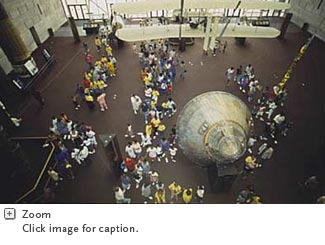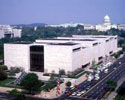 While
the National
Center for Earth and Space Science Education was only
recently established in June 2005, the Center’s programs and
capabilities reflect a 10-year heritage of national education
programming that effectively bridges across science, technology,
engineering, and mathematics (STEM) content. While
the National
Center for Earth and Space Science Education was only
recently established in June 2005, the Center’s programs and
capabilities reflect a 10-year heritage of national education
programming that effectively bridges across science, technology,
engineering, and mathematics (STEM) content.
These national programs were developed
and piloted by the Laboratory for Astrophysics at the Smithsonian’s
National
Air and Space Museum from 1990-1996. The programs
were transferred to the Space Science Education and Research
department at Challenger
Center for Space Science Education in 1996 where they
were broadened into national initiatives.
On June 1, 2005 the department’s
staff and programs formally separated from Challenger Center
to form USRA’s new National Center for Earth and Space Science
Education. The Center Director is Dr. Jeff Goldstein. |
Journey
through the Universe
A national science education initiative that engages entire
communities—students, teachers, families, and the public—using
education programs in the Earth and space sciences and space
exploration to inspire and educate. School programs for thousands
of students, professional development for educators, programs
for families and the public, exhibitions, distance learning
programs, and experiences delivered via the web, all provide
multiple pathways for learning.
A community uses the content and programming resources available
to create a customized Journey through the Universe
program that reflects their strategic needs in STEM education;
can be delivered systemically across an entire school district;
and is designed to be sustainable. Programming is delivered
by a National Team of engineers and scientists, and master
science educators, from the Center and research and education
organizations across the nation.
Voyage:
A Journey through our Solar System
An international space science education initiative that uses
a Voyage one to 10-billion scale model of the Solar
System permanently installed in a community as a centerpiece
for community-wide science education programming. The program
was launched in October 2001 with the permanent installation
of the Voyage scale model Solar System on the National
Mall in Washington, DC, spanning a 2,000 ft (600 m) pathway
between the National Air and Space Museum and the Smithsonian’s
Castle Building.
Replicas of the exhibition are
now available for permanent placement at community sites around
the world. The vision is growing an international network
of Voyage Communities. The exhibition includes a
package of curriculum and educational resources that supports:
visitors to the exhibition, grade K-12 teachers, grade K-12
students, informal educators in museums and science centers,
families, and the public. Community-wide programming using
the Voyage
content on Solar System science and exploration is available
through the Center’s Journey through the Universe
program.
MESSENGER
Education and Public Outreach
Education activities in support of NASA’s MESSENGER spacecraft
mission to the planet Mercury. The Center oversees: 1) the
development of grade 5-8 and 9-13 Education Modules—each a
theme-based compendium of inquiry-based lessons on Solar System
science and exploration; 2) delivery of Solar System content
through community initiatives, e.g., Journey through the
Universe, and 3) the creation, training, and support
of a cadre of master science educators—the MESSENGER Educator
Fellows—which in turn train 3,000 teachers a year on the Education
Modules, corresponding to 27,000 teachers trained over the
mission lifetime (through 2012), and translating into experiences
for over 1 million students.
Family Science Night
at the Smithsonian’s National Air and Space Museum
School field trips designed for family learning for schools
from 10 Washington, DC, metro-area school districts.
An after hours program in the most visited museum on the planet,
it includes time in the galleries, a ‘performance’ by a space
science researcher, and an IMAX film. The researcher’s
presentation is the centerpiece of the evening, providing
students and their parents a personal window on the process
of scientific inquiry. Since 1993, 114 programs have
been held for 38,900 attendees from 143 schools, corresponding
to an attendance of 340 per program.
Solar System Research
The Center is committed to ensuring that all its science education
and public outreach initiatives truly reflect the research
experience, and are accurate in both scientific content and
process. To best serve this need the Center maintains
an in-house space science research group. Staff researchers
split their time between research and national education and
public outreach. The Center's research programs—
- Cooperative Research
in Planetary Astronomy
Research efforts in collaboration with the Laboratory for
Extraterrestrial Physics at NASA's Goddard Space Flight
Center. Ground-based astronomy and laboratory spectroscopic
studies are undertaken that support current, recent, and
anticipated NASA planetary flight missions.
- Composition and
Structure of Terrestrial Planetary Atmospheres
Ultra-high resolution ground-based infrared spectroscopy
of the terrestrial planet atmospheres. Chemical and
isotopic composition, thermal structure, and wind dynamics
are studied in the upper atmospheres of Venus and Mars to
understand the evolution of these atmospheres and planetary
environs.
- Star Formation and
the Origins of the Solar System
Research exploring interstellar shock wave triggering of
solar system formation. Theoretical modeling and computer
simulations of processes involved in the interaction between
shock waves and interstellar clouds are investigated, with
special emphasis on the mixing and transport of material
from a shock wave into a forming solar system.
|
